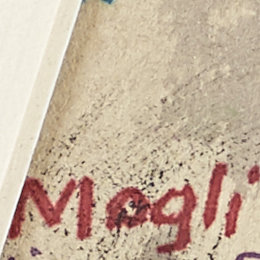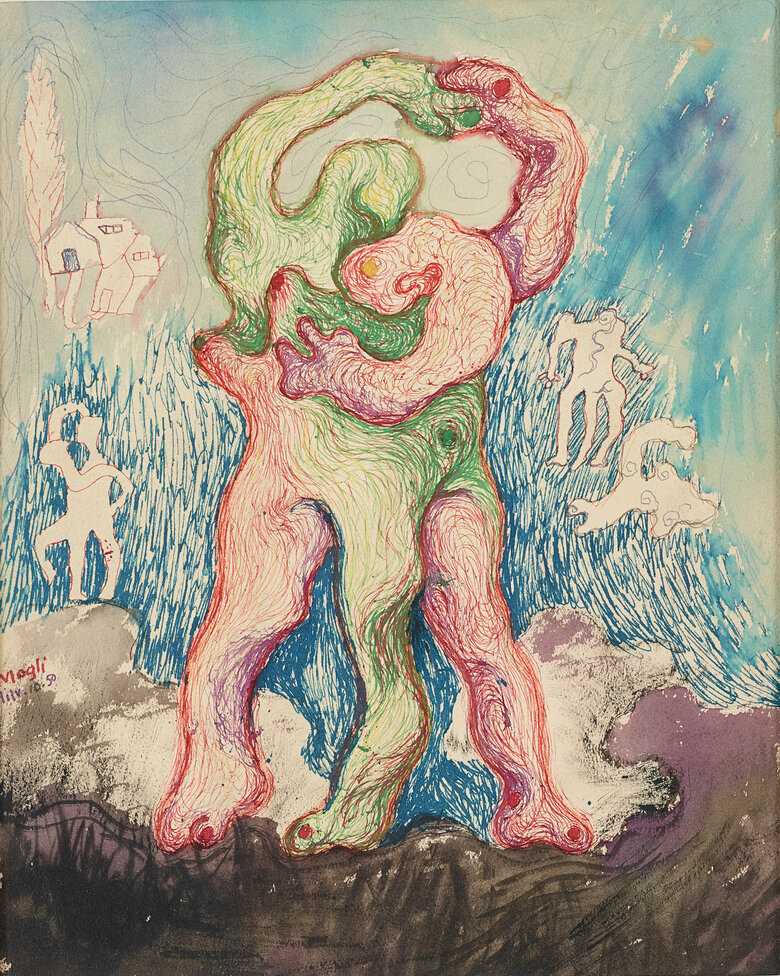Salem El Habashi, better known as Mogli, was born in Indonesia in 1912 to a Yemeni family[i]. His childhood was marked by his time spent on the rural farmlands of Java Island, Indonesia[ii]. At the...


SALEM EL HABASHI, Egypt (1924)
Bio
Written by Retaj Darwish
Salem El Habashi, better known as Mogli, was born in Indonesia in 1912 to a Yemeni family[i]. His childhood was marked by his time spent on the rural farmlands of Java Island, Indonesia[ii]. At the age of 13, he moved briefly to the Netherlands before settling in Egypt, where he spent much of his life. In 1937, El Habashi enrolled at the School of Farouk I and pursued further studies at Cairo's Medical School before shifting his interest to the art of calligraphy[iii]. Ultimately, he completed a diploma in calligraphy after finishing his higher education.
El Habashi began his painting career in Egypt. He emerged as an important figure in the Egyptian art scene between 1948 and 1950s and continued his artistic endeavors until 1961[iv]. During this period, he relocated frequently between the Netherlands and Egypt, establishing his place in both artistic communities. His artistic practice was deeply influenced by the natural and rural surroundings he grew up in during his childhood in Indonesia, which informed much of his landscape works[v]. Also, his use of vibrant colors, organic forms, and intricate patterns can be traced back to Indonesia's visual traditions and natural beauty. In1949, after a brief return to the Netherlands, he returned to Egypt and began actively exhibiting with the Contemporary Art Group, a pivotal moment in his career.
As a member of the Egyptian Contemporary Art Group[vi], El Habashi's work was deeply tied to the socio-political context of his time. The group, whose first declaration in 1946 sought to dismantle the separation between art and material conditions, was engaged in reflecting on modernity, post-colonial identity, class struggles, and anti-colonial sentiments. These themes were especially prominent in El Habashi’s works, which he exhibited during the politically turbulent post-World War II era.
A significant influence on El Habashi's career was his mentor, Hussein Youssef Amin, the founder of the Contemporary Art Group. Amin's role in shaping El Habashi's artistic journey is inspiring and commands respect. Amin encouraged self-discovery and discipline among the artists he mentored, hosting gatherings at his villa near the Pyramids, which became a hub for the younger artists. He taught his students, including El Habashi, the importance of unity and synthesis in their work, urging them to find subjects that reflected their own temperaments and philosophies rather than conforming to European artistic trends.
El Habashi's early works were rooted in Surrealism, often characterized by dense compositions that incorporated figurative and symbolic elements[vii]. As an artistic movement, Surrealism sought to unlock the unconscious mind, often merging dreamlike imagery with reality to evoke emotional and psychological responses. El Habashi’s notable early piece, The Witch, 1946[viii], a pencil-on-paper drawing, exemplifies this phase. It depicts a nude figure with tangled bulky limbs in a surreal and unsettling composition. The limbs, namely the hands, seem disjointed, reaching out and twisting inward, making the body seem in constant motion. The figure seems massive and dense, occupying much of the drawing's rectangular composition. However, the interplay of hand-like shadows on the right side of the drawing creates a dynamic, almost frantic sense of motion. The pencil’s muted grayscale tones add to the subdued intensity of the work, while the balance of lighter and darker shadows enhances the depth. The Witch,1946, unsettling quality reflect the surrealist focus on the subconscious, making it a hallmark of El Habashi’s early style.
As he evolved as an artist, El Habashi began to experiment with different styles and techniques. By the 1950s, his work had shifted towards more colorful and naïve compositions, blending influences from his native Indonesia with Egyptian themes. One such piece is a figurative abstraction titled Fusionnement (Fusion), 1950[ix], part of the Ramzi and Saeda Dalloul Art Foundation collection. Executed in watercolor and ink, the painting depicts two intertwined figures, their limbs merging and blurring as they embrace. Though resembling the contortion of his earlier work, Witch, 1946, this piece is more abstract as the figures remain faceless, flat, and fluid. Their bodies' vibrant reds and greens blend into one another, creating an organic form that suggests a deep, symbolic connection. In the background, more miniature, entangled figures drawn in reduced forms in whiteagainst a blue background. The duo-like figures seem to dance amidst a dreamlike landscape of soft clouds, with floating minute houses, and trees, further emphasizing the surreal quality of the scene. The contrast between the prominent central figures and the more minor, more detached elements in the background creates a striking tension in the painting’s composition.
El Habashi's use of watercolor allows for smooth transitions between colors. At the same time, the black ink outlines structure the otherwise free-flowing forms, giving the painting a dynamic yet restrained feel. The fluidity of the figures' forms mirrors the thematic exploration of identity and relationships, where individuality and unity coexist and often conflict. The merging limbs not only symbolize physical closeness but also reflect El Habashi's recurring focus on the fluid boundaries of self and other, identity and collective experience. This piece, with its abstract forms and vibrant colors, represents a significant evolution in El Habashi's style, moving away from early Surrealism toward a more abstract, colorful representation of human connection rooted in vibrant Indonesian inspirations of ethnic folk art characterized by naïve and colorful depictions, and symbolic mythical Egyptian heritage. Fusionnement, 1950 explores the complexities of human relationships and identity through a deeply personal yet universally resonant visual language.
Later in his career, El Habashi’s work became increasingly abstract, moving away from figurative representations and embracing geometric and symbolic motifs[x]. For instance, Nostalgia I, 1955[xi], executed with oil on Celotex, a toxic material used for insulation, shows a central figure, seemingly seated, rendered with bold, black contours that resemble ancient Egyptian hieroglyphs and Islamic calligraphy. The figure's body is adorned with bright red, yellow, and blue zigzagging patterns against a contrasting earthy, muted background of brown and orange. The painting reflects a synthesis of Egyptian iconography with abstract geometric forms. Moreover, the artist draws the figure with one continuous line, creating a flat, simplified shape. The work surfaces traditional motifs with a modernist approach, emphasizing cultural heritage and contemporary abstraction.
El Habashi explored spiritual and universal themes. For example, in Nostalgia II, 1955[xii], we see swirling lines and recurrent patterns that evoke Islamic mysticism and cosmic imagery. The composition features a complex web of spirals, orbs, and delicate white lines set against deep red, brown, and black backgrounds. These dynamic forms move across the surface, creating a hypnotic effect. The recurring motifs, reminiscent of both natural elements and mystical symbols, highlight El Habashi's interest in the spiritual and the abstract, moving beyond the physical world and into the realms of mythology and metaphysics.
Although his archival footprint remains minimal, El Habashi's contributions to Egyptian modern art are significant. His work, deeply rooted in his socio-political context, explored themes of identity, sexuality, and geopolitics while blending Egyptian and Indonesian influences. His unique experimental style, marked by a synthesis of Surrealism, abstraction, and cultural symbolism, continues to resonate in the contemporary art world, solidifying his place as a critical figure in the Egyptian modern art movement.
Edited by Elsie Labban and Wafa Roz
Endnotes
[i] https://www.christies.com/en/lot/lot-6163311.
[ii] https://www.sothebys.com/en/auctions/ecatalogue/2017/20th-century-art-middle-east-l17228/lot.31.html.
[iii] https://www.christies.com/en/lot/lot-6163311.
[iv] https://www.christies.com/en/lot/lot-6163311.
[v] https://www.sothebys.com/en/auctions/ecatalogue/2017/20th-century-art-middle-east-l17228/lot.31.html.
[vi] Contemporary Art Group: Cairo 1946. Art Dubai Modern 2018. Cairo: Karim Francis Gallery, 2018.
[vii] https://www.sothebys.com/en/auctions/ecatalogue/2017/20th-century-art-middle-east-l17228/lot.31.html.
[viii] https://almasargallery.com/salem-al-habashi-mogli/
[ix] https://dafbeirut.com/en/salem-el-habashi/works/784-233959-fusionnement-fusion
[x] Contemporary Art Group: Cairo 1946. Art Dubai Modern 2018. Cairo: Karim Francis Gallery, 2018.
[xi] https://almasargallery.com/salem-al-habashi-mogli/
[xii] https://almasargallery.com/salem-al-habashi-mogli/
Sources
Almasar Gallery. Salem Al Habashi (Mogli).
Accessed October 8, 2024. https://almasargallery.com/salem-al-habashi-mogli/.
Christie's. Salem Al-Habschi (1912-1961). Lot 34, Modern & Contemporary Art. October 22, 2018. https://www.christies.com/en/lot/lot-6163311.
Contemporary Art Group: Cairo 1946. Art Dubai Modern 2018. Cairo: Karim Francis Gallery, 2018.
Hosni, Enas. Contemporary Art Group: A Surviving Wealth of Art. Foreign Cultural Information Department, 2009.
Kane, Patrick. Art Education and the Emergence of Radical Art Movements in Egypt: The Surrealists and the Contemporary Arts Group, 1938–1951. The Journal of Aesthetic Education 44, no. 4 (2010): 95-119.
Lenssen, Anneka, Sarah A. Rogers, and Nada M. Shabout, eds. Modern Art in the Arab World: Primary Documents. New York: The Museum of Modern Art, 2018.
Sotheby's. Salem Al-Habschi. Lot 31, 20th Century Art: Middle East. October 24, 2017. https://www.sothebys.com/en/auctions/ecatalogue/2017/20th-century-art-middle-east-l17228/lot.31.html.
CV
Selected Group Exhibitions
2016
Remembered II @ The Art Lounge, Almasar Gallery, Cairo, Egypt
2012
Remembered, Almasar Gallery, Cairo, Egypt
Press
«رؤى معاصرة » لرواد الفن التشكيلى بمعرض جاليري «المسار» » صحيفة فنون الخليج.pdf
طباعة الاخبار-جاليرى المسار يستعد لإطلاق معرض رؤى معاصرة يضم 70 عملا فنيا.pdf
شبكة رؤية الإخبارية حركة الفن التشكيلي المصري في المعرض السنوي لجاليري مسار.pdf
بوابة الأهرام.pdf
SALEM EL HABASHI Artwork
Become a Member
Join us in our endless discovery of modern and contemporary Arab art
Become a Member
Get updates from DAF
Follow Artists
Save your favourite Artworks
Share your perspectives on Artworks
Be part of our community
It's Free!
We value your privacy
TermsCookiesPrivacy Policies
Become a Member
Get updates from DAF
Follow Artists
Save your favourite Artworks
Share your perspectives on Artworks
Be part of our community
It's Free!
We value your privacy
TermsCookiesPrivacy Policies
Become a Member
Get updates from DAF
Follow Artists
Save your favourite Artworks
Share your perspectives on Artworks
Be part of our community
It's Free!
We value your privacy
TermsCookiesPrivacy Policies
Welcome to the Dalloul Art Foundation
Thank you for joining our community
If you have entered your email to become a member of the Dalloul Art Foundation, please click the button below to confirm your email and agree to our Terms, Cookie & Privacy policies.
We value your privacy, see how
Become a Member
Get updates from DAF
Follow Artists
Save your favourite Artworks
Share your perspectives on Artworks
Be part of our community
It's Free!
We value your privacy
TermsCookiesPrivacy Policies




